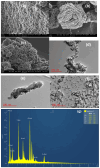Design of S-Scheme CuInS2/CeO2 Heterojunction for Enhanced Photocatalytic Degradation of Pharmaceuticals in Wastewater
- PMID: 39865666
- PMCID: PMC11803712
- DOI: 10.1021/acs.langmuir.4c04175
Design of S-Scheme CuInS2/CeO2 Heterojunction for Enhanced Photocatalytic Degradation of Pharmaceuticals in Wastewater
Abstract
The release of common medications and illegal drugs into the environment could be potentially harmful to the ecosystem and hamper the behavior and growth of plants and animals. These pollutants gain access to water through sewage and factory discharges and have been found to exceed safety limits in water bodies. Therefore, there is an urgent need for improved wastewater purification systems. In this study, semiconductor-based heterojunction photocatalyst CuInS2/CeO2, synthesized through a facile solvothermal process, was explored for the photocatalytic degradation of ciprofloxacin, commonly used antibiotics. Studies on the electronic properties of the heterojunction revealed interfacial characteristics that were suitable for enhanced charge carrier separation and transport and a potential S-scheme charge transfer mechanism. The heterojunction achieved ∼90% efficiency for the degradation of CIP compared to 60% and 12% reported for CeO2 and CuInS2, respectively. This shows an improvement in the activity, which results from the improved charge carrier properties of the heterojunction. Further investigation of the charge transfer mechanism through radical scavenging experiments identified •OH, O2•-, and h+ as active species contributing to the catalyst's efficacy. Based on X-ray photoelectron spectroscopy analysis, a proposed S-scheme charge transfer mechanism was suggested for the CuInS2/CeO2 heterojunction. The findings indicate the potential of the CuInS2/CeO2 heterojunction as a promising photocatalyst for treating waste effluents from the pharmaceutical industry.
Conflict of interest statement
The authors declare no competing financial interest.
Figures








Similar articles
-
In-situ construct CuInS2/Bi/Bi2MoO6 S-scheme/Schottky dual heterojunctions catalyst for enhanced photocatalytic degradation of diclofenac sodium.Environ Pollut. 2024 Jun 15;351:124077. doi: 10.1016/j.envpol.2024.124077. Epub 2024 May 3. Environ Pollut. 2024. PMID: 38705447
-
Investigation of the photoelectric properties of nanostructured CeO2/Cu2O heterojunction: Photocatalytic degradation of sulfadiazine in water.Environ Res. 2025 Mar 1;268:120788. doi: 10.1016/j.envres.2025.120788. Epub 2025 Jan 9. Environ Res. 2025. PMID: 39793874
-
Enhanced aquatic antibiotic removal via dual piezoelectric photocatalyst CdS/BiFeO3 S-scheme heterojunction: Mechanism, degradation pathway, and toxicity evaluation.J Colloid Interface Sci. 2025 Aug 15;692:137541. doi: 10.1016/j.jcis.2025.137541. Epub 2025 Apr 9. J Colloid Interface Sci. 2025. PMID: 40209426
-
A critical review on relationship of CeO2-based photocatalyst towards mechanistic degradation of organic pollutant.Chemosphere. 2022 Jan;286(Pt 1):131651. doi: 10.1016/j.chemosphere.2021.131651. Epub 2021 Jul 24. Chemosphere. 2022. PMID: 34346345 Review.
-
Construction of Fe2O3/g-C3N5 heterojunction and photocatalytic degradation of antibiotics and mechanism analysis.J Environ Sci Health B. 2025;60(2):79-90. doi: 10.1080/03601234.2025.2455303. Epub 2025 Jan 23. J Environ Sci Health B. 2025. PMID: 39849682 Review.
References
-
- Mukherjee I.; Cilamkoti V.; Dutta R. K. Sunlight-Driven Photocatalytic Degradation of Ciprofloxacin by Carbon Dots Embedded in ZnO Nanostructures. ACS Appl. Nano Mater. 2021, 4, 7686–7697. 10.1021/acsanm.1c00883. - DOI
-
- Massima Mouele E. S.; Tijani J. O.; Badmus K. O.; Pereao O.; Babajide O.; Zhang C.; Shao T.; Sosnin E.; Tarasenko V.; Fatoba O. O.; Laatikainen K.; Petrik L. F. Removal of Pharmaceutical Residues from Water and Wastewater Using Dielectric Barrier Discharge Methods—A Review. Int. J. Environ. Res. Public Health 2021, 18, 1683–1695. 10.3390/ijerph18041683. - DOI - PMC - PubMed
-
- Masekela D.; Hintsho-Mbita N. C.; Sam S.; Yusuf T. L.; Mabuba N. Application of BaTiO3-based catalysts for piezocatalytic, photocatalytic and piezo-photocatalytic degradation of organic pollutants and bacterial disinfection in wastewater: A comprehensive review. Arab. J. Chem. 2023, 16, 10447310.1016/j.arabjc.2022.104473. - DOI
MeSH terms
Substances
LinkOut - more resources
Full Text Sources

